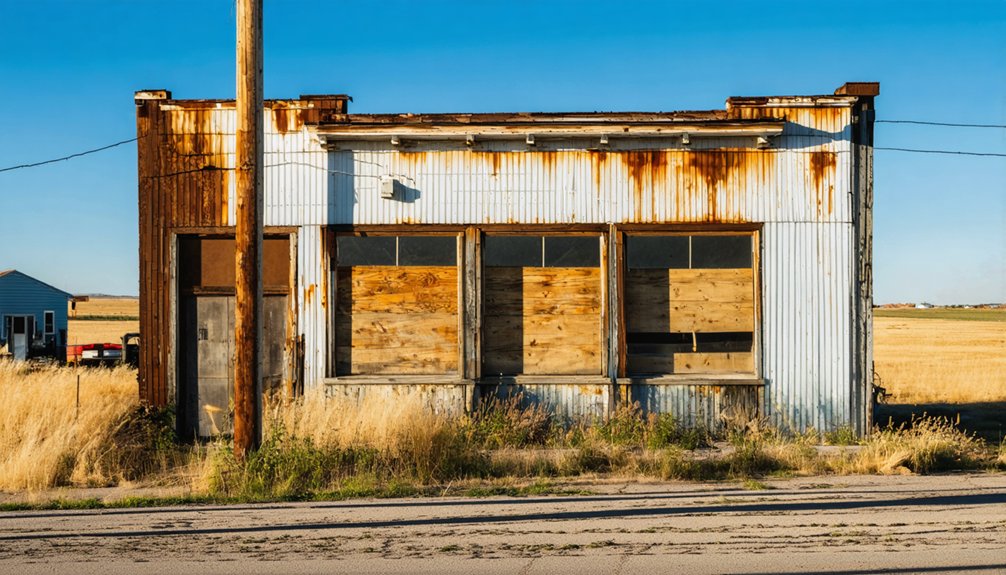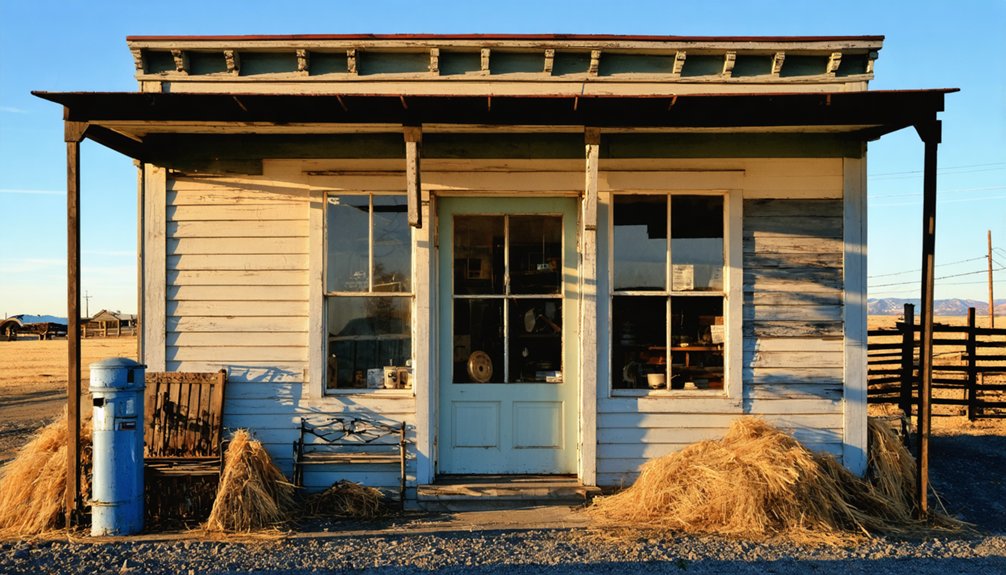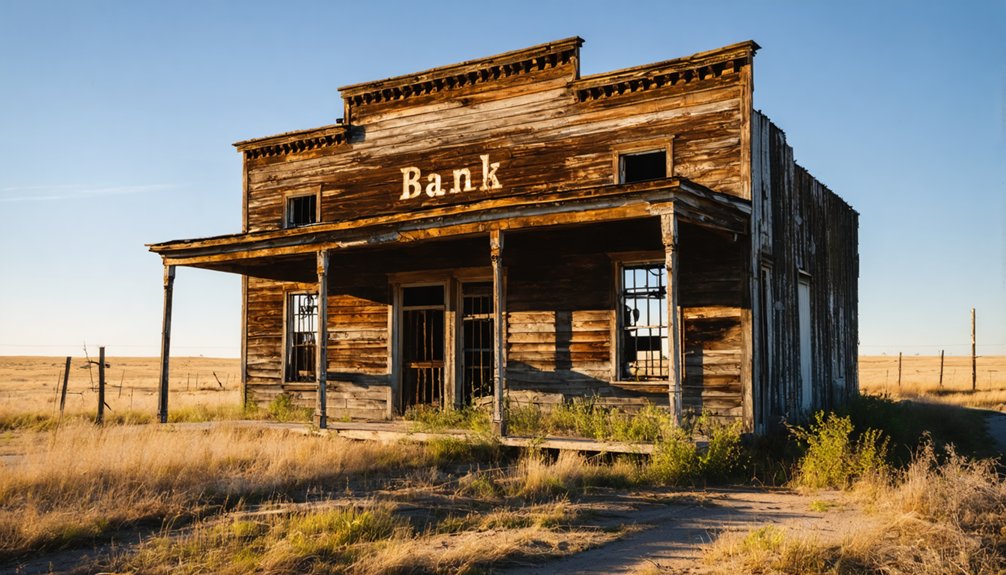While ghost towns in South Dakota offer low entry costs and tourism potential, you’ll need careful due diligence to make safe investments. Historical properties can appreciate with the state’s $5.1 billion tourism market, but you must evaluate utility access, infrastructure needs, and property rights thoroughly. Your success depends on selecting locations with economic diversification potential, stable transportation networks, and clear titles. Understanding market volatility and insurance requirements will reveal your smartest investment opportunities.
Key Takeaways
- Conduct thorough title searches and resolve property disputes before investing to ensure legal ownership and prevent future complications.
- Focus on ghost towns near established tourist routes and Mount Rushmore to leverage existing visitor traffic and infrastructure.
- Secure specialized vacant property insurance covering vandalism, fire, and liability to protect your investment in historic structures.
- Prioritize locations with existing utility access or feasible infrastructure improvements to minimize development costs and risks.
- Research historical property transactions and local economic indicators to identify areas with potential for sustainable tourism growth.
Understanding Ghost Town Investment Dynamics
While ghost town investments may seem enticing due to their low entry costs, they represent a complex interplay of economic forces that require careful analysis.
You’ll need to understand how boom-bust cycles shape ghost town demographics, particularly in resource-dependent areas where population shifts can quickly transform thriving communities into vacant properties. Cities lacking proper amenity accessibility scores often struggle to maintain a stable population base.
Investment diversification is vital since these markets often suffer from economic monocultures. Modern studies of rural community decline show similar patterns to historical ghost towns.
You’re dealing with volatile labor markets that can spike temporarily but lack sustainable foundations.
Watch for warning signs like speculative price inflation and oversupply of housing that exceeds actual demand.
Be wary of locations where infrastructure and amenities are deteriorating, as these factors accelerate population decline.
Your success depends on identifying areas with potential for economic diversification beyond their original boom industry.
Historical Value Assessment Methods
Before investing in ghost town properties, you’ll need to conduct thorough historical value assessments using established methodologies from the National Register criteria. Start by examining historical context through extensive documentation of the town’s establishment, economic activities, and decline patterns. This analysis will directly impact your investment’s potential value.
Focus on archaeological evidence that reveals community structures and technological developments, as these factors often drive heritage tourism appeal. You’ll want to evaluate both material culture and landscape features, combining archaeological findings with historical records to build a detailed value profile.
Consider working with expert assessments while factoring in economic potential. The property’s authenticity, structural integrity, and preservation state will greatly influence your return on investment when balanced against development costs.
Property Rights and Legal Considerations
Understanding property rights and legal considerations is critical when investing in South Dakota ghost towns, particularly given the state’s complex adverse possession laws.
When evaluating potential investments, you’ll need to navigate existing property disputes and legal frameworks carefully to protect your interests. Regular property inspections help prevent squatters from establishing a long-term presence that could lead to adverse possession claims. The recent Ghost Town of Lily case demonstrates how abandoned properties can attract unauthorized occupants.
- You must conduct thorough title searches and resolve any competing claims through quiet title actions before finalizing your investment.
- Property valued over $500 requires secure storage and proper notification if abandoned by previous occupants.
- You’ll need to monitor the property regularly to prevent unauthorized occupation, as squatters can gain ownership rights after 20 years.
- Consider that color of title combined with tax payments can reduce the adverse possession period to 10 years, making proactive property management essential.
Tourism Revenue Potential Analysis
As tourism spending in South Dakota reached $5.1 billion in 2024, ghost town investments offer compelling revenue potential through strategic positioning in the state’s growing heritage tourism market.
You’ll tap into a sector that supports 59,000 jobs and generates $399 million in tax revenues statewide.
Ghost town demographics align perfectly with current tourism trends, as visitors increasingly seek authentic historical experiences. Peak season visits occur from late May through September.
While Mount Rushmore remains the primary draw, you can capitalize on the rising visitor spending in rural areas, particularly in the Southeast and Black Hills regions.
Your investment can target the 14.7 million annual tourists through diversified revenue streams: guided tours, themed events, and specialized accommodation.
With hotel revenues up 6% and growing international interest, ghost towns present a unique opportunity in South Dakota’s tourism landscape.
The state’s focus on collaborative marketing between East and West River regions enhances visibility for heritage sites across all territories.
Risk Management Strategies
You’ll need to analyze South Dakota’s economic indicators, including tourism growth rates and property appreciation patterns, to gauge the ghost town’s investment potential.
Your due diligence should include researching historical property transactions in similar ghost towns across the state, focusing on sites that have successfully transformed into tourist destinations. Consider checking current road conditions before conducting on-site property inspections, as access routes to remote locations can change dramatically with weather and seasons.
Protect your investment by securing thorough insurance coverage that specifically addresses historic property risks, while establishing clear legal documentation of ownership rights and compliance with South Dakota’s preservation laws. Given the unoccupied nature of ghost towns, it’s critical to implement physical access controls to prevent unauthorized entry and potential security breaches.
Evaluate Local Economic Trends
Recent economic data from South Dakota reveals significant challenges that investors must consider when evaluating ghost town opportunities. Economic indicators point to stagnant GDP growth, while demographic shifts show population growth slowing to 0.69% in 2024. Towns like Lead have experienced remarkable transformation, with home values nearly doubling between 2020-2022. Real household incomes have shown strong historical performance, with 25% growth from 1990 to 2020.
You’ll need to carefully analyze these trends before committing capital to ghost town investments.
- Workforce shortages persist with 33,000 open jobs versus 10,000 unemployed, limiting economic growth potential.
- Growth concentrates in Minnehaha and Lincoln Counties while rural areas face population decline.
- Property tax pressures are increasing, with 62 school districts implementing opt-outs totaling $34.6 million.
- Small towns show high market volatility and price corrections, suggesting careful valuation analysis is essential.
Your investment success depends on understanding these local economic fundamentals rather than speculating on short-term price movements.
Historical Property Value Analysis
Understanding historical property values in ghost town investments requires rigorous risk assessment across multiple dimensions.
You’ll find that ghost town valuation patterns, as evidenced by Swett’s price drop from $399,000 to $250,000, demonstrate significant market volatility. Historical significance alone won’t guarantee stable value retention.
Your analysis should factor in the property’s rapid decline since 1931, which directly impacts asset worth.
You’re looking at a market where traditional valuation methods don’t apply – comparable sales like Scenic, South Dakota, show that institutional buyers often drive pricing differently than individual investors.
Consider that physical deterioration accelerates value loss, while media attention and unique features can temporarily boost market interest.
Success depends on understanding these historical pricing patterns and preparing for substantial variances in property valuation over time.
Insurance and Legal Protection
When investing in ghost town properties, extensive insurance coverage and legal protection form the cornerstone of risk management strategy. Your vacant property requires specialized insurance types and compliance with legal requirements to protect your investment against potential risks and liabilities.
- Secure specialized vacant home insurance that covers fire, vandalism, and theft, especially critical since these properties remain unoccupied for extended periods.
- Implement enhanced security measures including surveillance systems and regular property inspections to reduce insurance premiums and mitigate risks.
- Maintain strict compliance with local zoning regulations and mandatory disclosure requirements to prevent policy cancellations.
- Partner with insurance brokers experienced in ghost town properties to secure thorough coverage, including general liability and property damage protection, while managing limited insurer options in this unique market.
Infrastructure Development Opportunities

Your infrastructure assessment should begin with mapping existing utility connections, noting that many ghost town sites lack modern water, power, and telecommunications systems that would require significant capital investment.
You’ll need to evaluate transportation access points, including the condition of existing roads, bridges, and potential rail-to-trail conversions that could enhance site connectivity.
Based on structural engineering reports, prioritize building restoration projects by focusing first on historically significant structures with intact foundations and minimal environmental hazards, which typically represent lower-risk, higher-return investment opportunities.
Current Utility Access Status
Since South Dakota’s utility landscape is undergoing significant transformation, investors should carefully evaluate the current infrastructure status of ghost town properties.
You’ll need to assess utility access challenges, particularly in rural and tribal areas where outdated systems may limit development potential.
- Water and wastewater capacity is expanding statewide, with treatment capacity increasing 50% to 30 million gallons daily by 2025.
- The $15.4 billion utility merger between Black Hills Corp. and NorthWestern Energy could improve service coverage in remote areas.
- Many ghost towns lack modern wastewater treatment infrastructure, requiring substantial new investment.
- Broadband infrastructure is being prioritized with $250 million in federal grants over 5 years, particularly benefiting tribal regions.
Critical infrastructure evaluation will determine your investment viability and potential renovation costs.
Transportation Network Assessment
Beyond utility considerations, understanding the transportation network surrounding ghost town investments reveals both challenges and possibilities.
You’ll find most access routes are unpaved, with gravel roads like those serving Mystic being typical, creating transportation challenges for development plans.
You can leverage existing infrastructure by focusing on sites near the Mickelson Trail or other repurposed rail corridors, which provide established recreational access points.
To maximize your investment potential, consider properties where accessibility improvements are feasible – particularly locations where road paving or trail connections could enhance visitor access.
The strategic development of multimodal transportation options, including bike and hiking trails, can transform isolated locations into viable tourism destinations while maintaining their historical character and minimizing environmental impact.
Building Restoration Priorities
When investing in South Dakota ghost towns, prioritizing building restoration requires a strategic balance between historical preservation and infrastructure development.
You’ll find multiple funding sources available through the Deadwood Historic Preservation Commission and EPA programs to address restoration challenges, with grants up to $2 million for qualified projects.
- Assessment of structural integrity and hazardous materials must precede any restoration work.
- Historic properties on National and State Registers qualify for specialized grants and loans.
- Environmental cleanup costs average $11 million for high-priority sites near populated areas.
- Infrastructure upgrades can integrate modern utilities while maintaining historic authenticity.
Your investment strategy should target properties that combine historical significance with redevelopment potential.
The most successful projects leverage both preservation grants and environmental cleanup funds to create economically viable destinations that preserve South Dakota’s mining heritage.
Heritage Preservation Income Streams

As heritage preservation efforts in South Dakota’s ghost towns gain momentum, multiple revenue streams have emerged to support their ongoing maintenance and development.
You’ll find diverse funding strategies, from tax-deductible donations through 501(c)3 historical societies to state humanities grants powering documentary productions and restoration work.
Community engagement drives substantial income through annual events like Galena’s open house, which draws up to 800 visitors.
You can tap into heritage tourism revenue through guided tours, festival admission fees, and merchandise sales.
Local economies benefit when you preserve these sites, as nearby towns see increased traffic in hospitality sectors.
The documentary filming industry and educational programs provide additional revenue channels.
While volunteer labor keeps costs down, sustainable income requires balancing visitor access with preservation needs.
Frequently Asked Questions
How Do Seasonal Weather Conditions Affect Ghost Town Property Maintenance Costs?
Like a financial storm, seasonal weather packs a punch on your maintenance costs, with extreme temperatures, precipitation, and wind driving up your repair expenses by roughly 30% annually through year-round impacts.
What Role Do Native American Tribal Rights Play in Ghost Town Ownership?
You’ll need to carefully verify tribal sovereignty claims and land reclamation rights before purchasing ghost towns, as Native American tribes maintain legal authority over historical territories and can challenge non-tribal ownership.
Can Modern Renewable Energy Projects Revitalize Abandoned Ghost Town Communities?
You’ll find renewable energy can effectively revitalize ghost towns by generating local tax revenue, creating jobs, and enabling community revitalization through infrastructure modernization, attracting new residents and sustainable economic growth.
How Do Nearby Active Mining Claims Impact Ghost Town Property Values?
You’ll find mining exploration can increase or decrease property values – it boosts values through potential mineral rights and infrastructure improvements, but it’ll reduce appreciation if environmental or safety concerns arise.
What Insurance Options Exist for Ghost Town Business Ventures?
You’ll need business liability coverage for visitor accidents and property insurance for structures. Consider bundling these in a Business Owner’s Policy, plus specialized coverage for unique ghost town risks.
References
- https://www.powderhouselodge.com/black-hills-attractions/fun-attractions/ghost-towns-of-western-south-dakota/
- https://www.youtube.com/watch?v=_0WNYsFLSLA
- https://www.sdpb.org/rural-life-and-history/2023-08-21/some-black-hills-ghost-towns-and-their-origins
- https://www.legendsofamerica.com/south-dakota-ghost-towns/
- https://www.blackhillshikingbikingandmore.com/old-mining-ghost-towns
- https://b1027.com/south-dakota-has-an-abundance-of-ghost-towns/
- https://history.sd.gov/archives/towndates.aspx
- https://urbannext.net/ghost-cities/
- https://www.richmondfed.org/-/media/richmondfedorg/publications/research/econ_focus/2011/q3/pdf/feature2.pdf
- https://ageconsearch.umn.edu/record/132433



